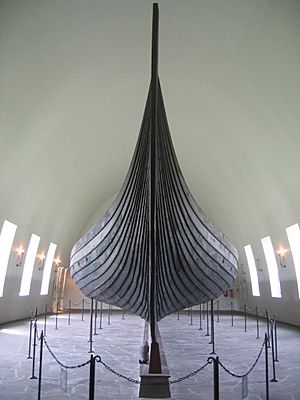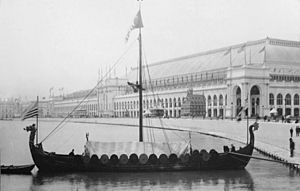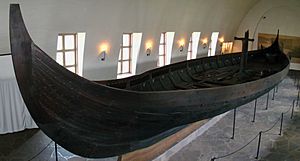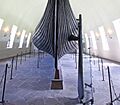Gokstad ship facts for kids

|
|
Quick facts for kids History |
|
|---|---|
| Name | Gokstadskipet |
| Completed | 9th century |
| General characteristics | |
| Type | Karve |
| Length | 23.80 metres (78.1 ft) |
| Beam | 5.10 m (16.7 ft) |
The Gokstad ship is an amazing Viking ship from the 800s. It was discovered inside a burial mound (a large dirt hill covering a grave) in Gokstad, Norway. Today, you can see this incredible ship at the Viking Ship Museum in Oslo. It's the biggest Viking ship ever found and kept safe in Norway!
Contents
Discovering the Gokstad Ship
The place where the ship was found was known as Gokstadhaugen. This name means "Gokstad mound" or "King's mound" in Old Norse. For a long time, people thought these names were just old stories.
In 1880, something exciting happened. The sons of the Gokstad farm owner were digging in the frozen ground. They had heard the old legends about the mound. Suddenly, they uncovered the front part of a boat!
News of their discovery quickly spread. Nicolay Nicolaysen, who was in charge of saving old Norwegian monuments, came to the site. He arrived in February 1880. When he saw the boat, he knew it was a very old and important find. He made sure the digging stopped right away.
Nicolaysen returned later with his team. The mound was still very large, about 50 meters long and 43 meters wide. Years of farming had made it flatter, but it was still 5 meters high. His team started digging into the side of the mound. On the second day, they found the ship's bow.

Building the Gokstad Ship
The Gokstad ship was built using a special method called clinker-built. This means its wooden planks overlap each other like roof tiles. Most of the ship was made from strong oak wood.
This ship was built for many purposes. It could be used for fighting wars, trading goods, and carrying people or cargo. It is about 23.80 metres (78.1 ft) long and 5.10 m (16.7 ft) wide. This makes it the largest ship at the Viking Ship Museum in Oslo.
The ship was steered by a large rudder. This rudder was attached to a big piece of wood on the outside of the ship. This special block of wood helped support the rudder.
The ship has 16 planks on each side. The planks at the bottom are narrow and get wider towards the top. Each oak plank is shaped to overlap the plank above and below it by about 30 millimeters. Iron rivets (like strong nails) hold the planks together. They are placed about 180 millimeters apart.
At the front of the ship, all the planks join neatly to the stem. The stem is carved from a single curved oak log. It forms the sharp front edge of the ship. The inside of the stem is hollowed out. This allowed builders to reach the rivets during construction or repairs.
Each crossbeam in the ship had a special ledge. This ledge held removable sections of the deck. Sea chests were placed on top of the deck when people were rowing. On longer trips, these chests were likely stored below deck. They helped make the ship heavier and more stable for sailing.
The bottom of the ship is designed to be light and flexible. The lowest nine planks on each side are thinner than the upper planks. They are about 2.5 centimeters thick. These planks were tied to the ship's frames using flexible branches called withies. This made the ship's bottom able to move slightly in rough seas without leaking.
The Gokstad ship was built for 32 oarsmen. The holes for the oars could be covered when the ship was sailing. It had a large square sail, about 110 square metres (1,200 sq ft) in size. Experts believe this sail could make the ship go over 12 knots (22 km/h; 14 mph) (about 14 miles per hour). The mast could also be raised and lowered.
Scientists used tree-ring dating to find out when the ship was built. They found that the timber was cut around 890 AD. This was a time when Vikings were expanding their influence in places like Dublin, Ireland and York, England. The Gokstad ship was likely built during the rule of King Harald Fairhair. This ship could carry a crew of 40 to 70 men. Its design proved to be very good for sailing on the open sea.
The Buried Man and His Treasures
During the excavation, a human skeleton was found inside a wooden burial chamber. The skeleton belonged to a man who was about 40 to 50 years old. He was strongly built and stood between 181 and 183 centimeters (about 5 feet 11 inches to 6 feet) tall. We don't know for sure who he was.
Around the man's body, archaeologists found the bones of twelve horses, six dogs, and even one peacock! In the 1920s, a professor thought the man might be King Olaf Gudrodson. However, this has not been fully proven.
The grave also contained other items besides the ship. These included three smaller boats, a tent, a sledge, and riding gear. It seems that many valuable items, like gold or silver, were taken from the grave long ago. No weapons were found either, even though weapons were usually an important part of a Viking man's burial.
Seeing the Ship Today
The Gokstad ship is now on display at the Viking Ship Museum. This museum is located on the Bygdøy peninsula in Oslo, Norway. You can also see the reconstructed burial chamber, two of the small boats, and two tent boards from the grave. Some other artifacts that survived the ancient plundering are also in the museum.
For many years, there was a discussion about moving the ship to a new location. But in 2012, the Education Minister decided that the ship would stay at Bygdøy.
Gokstad Ship Replicas
Many replicas (exact copies) of the Gokstad ship have been built.

- The Viking is an exact copy of the Gokstad ship. It sailed across the Atlantic Ocean from Bergen, Norway to Chicago in 1893. It was shown at the World's Columbian Exposition there. This replica is still on display near Chicago today.
- The Gaia ship is another exact replica. It was built in Norway between 1989 and 1990. In 1991, the President of Iceland named it Gaia. The ship was later given to the city of Sandefjord in 1993. The Gaia ship has a single oak mast and uses stones for ballast. It can reach speeds of ten knots with its large sail. It also has sixteen pairs of oars. In 1991, it sailed to North America to celebrate 1000 years since Leiv Eriksson found Vinland. The Gaia ship is now based in Sandefjord. It also sailed to the Rio de Janeiro Earth Summit in Brazil.
- Other replicas include Munin, a half-scale copy in Vancouver, British Columbia, Canada. There's also the Íslendingur at the Viking World museum in Iceland. The Hugin is in Ramsgate, England. And another replica is at the Hjemkomst Center in Moorhead, Minnesota.
See also
- Gjellestad ship, a longship found in 2019 that is similar in size to the Gokstad ship.
Related Reading
- Vinner, Max (2002)Boats of the Viking Ship Museum (Viking Ship Museum) ISBN: 978-8785180636
- Williams, Gareth (2014) The Viking Ship (British Museum Press) ISBN: 978-0714123400
Images for kids







